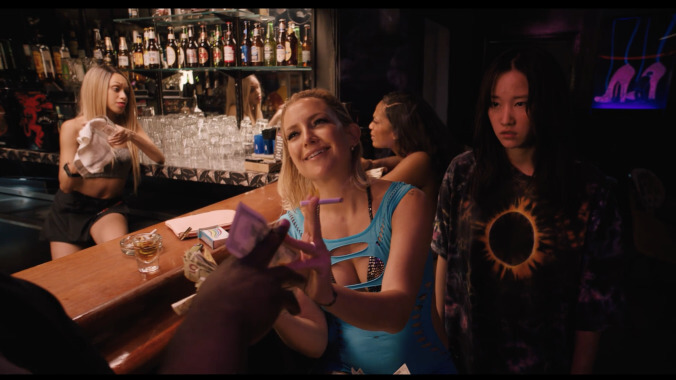Kate Hudson walks the walk in Mona Lisa And The Blood Moon
Hudson's terrific performance anchors director Ana Lily Amirpour's latest story about a special woman navigating a seedy environment

Movies so often try to increase the stakes of their action and chase sequences—seriously, does every action hero study parkour now?—so it’s refreshingly amusing when Mona Lisa And The Blood Moon deliberately lowers them, with one of the world’s slowest chase sequences. Craig Robinson, playing a cop with an injured leg and a single crutch, chases Kate Hudson, playing a stripper in too-high heels, down a New Orleans street at night. Both can barely even walk, but nobody in that party city much cares for the officer’s pleas to stop his suspect.
The real subject of the chase is the woman accompanying Hudson, an escapee from a mental institution named Mona Lisa Lee (Jeon Jong-seo, Burning). She’s a childhood refugee from North Korea, an intriguing plot point into which this movie does not delve further. Mona mostly grew up in a Louisiana institution referred to do by one cop as “The Home of Mentally Insane Adolescents,” and has decided on this night that it’s time to leave. Since she has the power to mentally control the movements of anyone who gets near her, it’s a fairly easy task.
Mona Lisa And The Blood Moon is the latest film from director Ana Lily Amirpour, and it’s tempting to call it A Girl Walks Home Alone From A Psych Ward At Night. In keeping with Amirpour’s style, it’s the story of a special woman walking through a danger-strewn landscape of society’s low-rung players. It’s a bit like a John Cassavetes or Harmony Korine film that just happens to have Stephen King’s Carrie as one of the characters, and a lot of synthesizers on the soundtrack.
At first, there seems to be a danger that Mona will fall victim to the silent Asian trope, as—like many Amirpour characters—she’s not exactly loquacious. Fortunately, it’s not long before she speaks, and even screams, though she’d rather let her actions do the talking. Saving Hudson’s Bonnie from a parking lot beatdown, she bonds with the first person not to judge her harshly. However, Bonnie is in fact more subtly judging her … as a potential meal ticket. When she sees Mona’s powers, she promptly brings her to the strip club and various ATMs to force the cash out of people’s hands. Even in a mostly debit card-centered society, the seedy side of New Orleans at night feels like a place where folks need actual cash, and thus still use cash machines, however ill-advisedly.
Bonnie’s a single mom, and her preadolescent son Charlie (Evan Whitten), initially resistant to company, becomes a genuine friend to Mona. Believing his mother sees him as a burden, he longs to get away, and it’s to the credit of this movie’s delightfully skewed moral compass that it actually persuades viewers to root for this underage kid to run away with an irresponsible and violent telekinetic. Amirpour dedicates the movie to the memory of her producer, Sina Sayyah, whom she describes as Charlie to her Mona Lisa, suggesting that there may be some autobiographical elements in the dynamic, though Sayyah was far from a child.
The overall plot, though, is less important than the portrait of the city fringes at night, and the people that inhabit the margins. Shot on location in Louisiana, it’s a vivid environment, populated by characters who genuinely seem like they belong, rather than actors who are perfectly cast. Ed Skrein is barely recognizable as a facially tattooed DJ named Fuzz, who seems almost stereotypically menacing until he gradually reveals more layers. There’s a lot of misdirection at play—upon escaping, Mona passes some scary-looking metalheads drinking beer. Violence seems imminent, but they not only give her a beer, but shoes, too. Anti-establishment types look out for each other on these streets; it’s the normal-seeming people, like the frat boy customers at “The Panty Drop,” who actually might perpetrate violence against a woman.
Hudson feels impressively like she belongs here, buried under a Brooklyn-ish accent and tattoos that catalogue a list of crossed-out boyfriend names. She never seems like an A-lister slumming, nor does she play her single-mom role for excess sympathy. She’s past letting her son’s precocious psych-talk get to her—“You’re toxic!,” he screams at her at one point, over her stripper-y fashion choices. But she also maybe doesn’t care as much as she should to prove she’s not toxic. Meanwhile, as the cop very slowly on Mona and Bonnie’s tail, Robinson portrays an average Joe on the law enforcement beat, a rarity on the big screen. He’s neither bastard nor hero; just a dude who likes Chinese food and wants to do his job.
Amirpour showcases Mona’s powers simply, showing that the best special effects can simply be the performers themselves. The activation of her powers is indicated by a simple dolly-counterzoom, that effect where the depth of field changes and the background seems to rush forward behind the character. She subsequently creates the effect by having the actors mirror each other, as if one character is being manipulated by the other. It’s a convincing, low-cost illusion that doesn’t violate the borderline neorealist tone, even as it injects a tiny bit of magic realism.
Did Mona get her abilities from some sort of top secret North Korean prison experiment? Who knows? She winces a bit seeing Donald Trump meeting Kim Jong-un on TV, but Mona Lisa And The Blood Moon is a movie that only tells you what the characters themselves would—and the title character protects her secrets. That leaves layers deliberately unexplored by Amirpour’s seemingly superficial narrative, or perhaps they’re simply concealed behind the simplicity of the characters’ behavior and activities. It’s less a story of the supernatural than an all-night party on the wrong side of town, with hints of danger, interesting strangers to meet, and an overall cool vibe that even lingers the morning after.